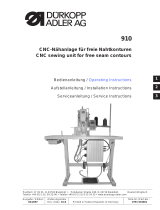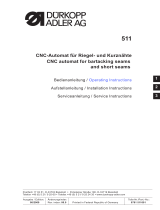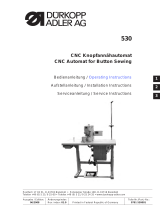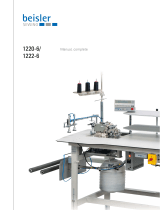Page is loading ...

510
CNC automat for bartacking seams
and short seams
Operating Instructions
Installation Instructions
Service Instructions
Postfach 17 03 51, D-33703 Bielefeld Potsdamer Straße 190, D-33719 Bielefeld
Telefon +49 (0) 5 21/ 59 25-00 Telefax+49(0)521/9252435 www.duerkopp-adler.com
1
2
3
Ausgabe / Edition: 02/2006 Printed in Federal Republic of Germany Teile-Nr.:/Part-No.: 0791 510001

Summary
Operating Instructions
Installation Instructions
Service Instructions
Interconnection-diagram
9890 510001 B

Foreword
This instruction manual is intended to help the user to become familiar
with the machine and take advantage of its application possibilities in
accordance with the recommendations.
The instruction manual contains important information on how to
operate the machine securely, properly and economically. Observation
of the instructions eliminates danger, reduces costs for repair and
down-times, and increases the reliability and life of the machine.
The instruction manual is intended to complement existing national
accident prevention and environment protection regulations.
The instruction manual must always be available at the
machine/sewing unit.
The instruction manual must be read and applied by any person that is
authorized to work on the machine/sewing unit. This means:
– Operation, including equipping, troubleshooting during the work
cycle, removing of fabric waste,
– Service (maintenance, inspection, repair and/or
– Transport.
The user also has to assure that only authorized personnel work on
the machine.
The user is obliged to check the machine at least once per shift for
apparent damages and to immediatly report any changes (including
the performance in service), which impair the safety.
The user company must ensure that the machine is only operated in
perfect working order.
Never remove or disable any safety devices.
If safety devices need to be removed for equipping, repairing or
maintaining, the safety devices must be
remounted directly after completion of the maintenance and repair
work.
Unauthorized modification of the machine rules out liability of the
manufacturer for damage resulting from this.
Observe all safety and danger recommendations on the machine/unit!
The yellow-and-black striped surfaces designate permanend danger
areas, eg danger of squashing, cutting, shearing or collision.
Besides the recommendations in this instruction manual also observe
the general safety and accident prevention regulations!

General safety instructions
The non-observance of the following safety instructions can cause
bodily injuries or damages to the machine.
1. The machine must only be commissioned in full knowledge of the
instruction book and operated by persons with appropriate
training.
2. Before putting into service also read the safety rules and
instructions of the motor supplier.
3. The machine must be used only for the purpose intended. Use of
the machine without the safety devices is not permitted. Observe
all the relevant safety regulations.
4. When gauge parts are exchanged (e.g. needle, presser foot,
needle plate, feed dog and bobbin) when threading, when the
workplace is left, and during service work, the machine must be
disconnected from the mains by switching off the master switch or
disconnecting the mains plug.
5. Daily servicing work must be carried out only by appropriately
trained persons.
6. Repairs, conversion and special maintenance work must only be
carried out by technicians or persons with appropriate training.
7. For service or repair work on pneumatic systems, disconnect the
machine from the compressed air supply system (max. 7-10 bar).
Before disconnecting, reduce the pressure of the maintenance
unit.
Exceptions to this are only adjustments and functions checks
made by appropriately trained technicians.
8. Work on the electrical equipment must be carried out only by
electricians or appropriately trained persons.
9. Work on parts and systems under electric current is not permitted,
except as specified in regulations DIN VDE 0105.
10. Conversion or changes to the machine must be authorized by us
and made only in adherence to all safety regulations.
11. For repairs, only replacement parts approved by us must be used.
12. Commissioning of the sewing head is prohibited until such time
as the entire sewing unit is found to comply with EC directives.
It is absolutely necessary to respect
the safety instructions marked by these signs.
Danger of bodily injuries !
Please note also the general safety instructions.

Index Page:
Preface and general safety hints
Part 1: Operating Instructions cl. 510
1. Description of product .......................................... 5
2. Description of proper use ....................................... 6
3. Subclasses ................................................. 6
4. Optional equipment ............................................ 7
5. Stands .................................................... 7
6. Technical data
6.1 Technicaldataofthesubclasses..................................... 8
7. Operating
7.1 Threading needle thread.......................................... 9
7.2 Adjust needle thread tension ....................................... 10
7.3 Open needle thread tension ....................................... 10
7.4 Adjust thread regulator........................................... 11
7.5 Wind on bobbin thread ........................................... 12
7.6 Change hook thread bobbin........................................ 13
7.7 Adjust bobbin thread tension ....................................... 14
7.8 Change needle ............................................... 15
8. Operating the control of cl. 510
8.1 The control panel .............................................. 16
8.1.1 Thekeys................................................... 16
8.2 Userinterface................................................ 18
8.2.1 Structureofmenu.............................................. 18
8.3 Alternumericalvalues,parametervalues,selectionofalternatives................ 19
8.3.1 Alternumericalvalues........................................... 19
8.3.2 Selectionofaparameter.......................................... 20
8.3.3 Selectionofalternatives.......................................... 20
8.4 Seampatterns................................................ 21
8.5 Mainmenu.................................................. 22
8.5.1 Seam pattern operation .......................................... 22
8.5.2 Programmingmode............................................. 27
1

Index Page:
8.5.3 Seam pattern sequences ......................................... 29
8.5.3.1 Switching the sequence programming mode on/off ......................... 29
8.5.3.2 Sequence programming mode ...................................... 32
8.5.4 Technicianmode .............................................. 32
8.5.4.1 Machine configuration ........................................... 36
8.5.4.2 User configurations ............................................. 45
8.5.4.3 Service functions .............................................. 49
8.5.4.4 Free contours ................................................ 63
8.5.4.5 Memory dongle ............................................... 71
8.6 Error messages ............................................... 78
8.6.1 Error categories ............................................... 78
8.6.2 Application messages ........................................... 79
8.6.3 Machine faults (DACIII) .......................................... 81
9. Sewing .................................................... 87
10. Maintenance
10.1 Cleaning and checking ........................................... 88
10.2 Oillubrication................................................ 89
11. Standard seam patterns ......................................... 90
12. Clamping feet................................................ 97
13. Numbering of menu items ........................................ 98

1
1. Description of product
The Dürkopp Adler 510 is a CNC automate for bartacking seams and
short seams. The available standard bartacks are size-adjustable and
can additionally be memorized in this modified shape.
Free seam contours can be programmed directly at the control panel
without any further devices.
Technical features
–
DAC control with control panel.
The following functions are available:
–
50 standard bartacks.
These bartacks can temporarily be modified as regards length,
width and speed. When switching off the automate the
modified values of the bartack sewn last are maintained.
–
40 modified bartacks can be memorized in addition.
–
9 free seam contours with a total of 5000 available stitches
can additionally be memorized.
So it is possible to attach e.g. small appliqués.
The coordinates are entered at the control panel. No further
devices are required.
–
25 seam pattern sequence programs with up to 20 seam
patterns per seam pattern sequence program can be created
and memorized.
–
The coordinates are entered with a precision of 0.1 mm.
–
In case of a rectangular contour of the fabric clamping feet the
modification of bartacks is automatically checked in order to
avoid a collision of needle and fabric clamping feet.
–
Counter of capacity and daily number of pieces.
–
Bartacks and/or seam pattern sequence programs and/or the
modification of special bartacks can be blocked.
–
The speed can be changed from 0 rpm (manual operation with
full operability of the x-y drive) up to 2700 rpm in
steps of 100 rpm.
–
Fabric drive via two step motors.
–
Drive of the automatic bartacker directly at the arm shaft via
brushless direct current motor.
–
Maximum sewing field size 40 x 20 mm.
–
Oil wick lubrication of arm shaft and driving shaft with two oil
reservoirs.
–
Service and maintenance work is supported by comprehensive test
programs.
5

2. Description of proper use
Class 510 is an automatic bartacker determined for processing light to
medium-weight material, i.e. fabrics made of textile fibres or leather.
Such sewing materials are used in the clothing industry and for the
production of home and car upholstery.
Furthermore, this automatic bartacker can also sew so-called technical
seams. However, in this case the user has to estimate the possible
risks (preferably in cooperation with DÜRKOPP ADLER AG) because
on the one hand such fields of application are comparatively rare and
on the other hand there is an immense variety of possibilities.
According to the result of this estimation suitable safety measures may
have to be taken.
Generally only dry fabrics must be processed on this automatic
bartacker. The material must not be thicker than 10 mm when
compressed by the lowered sewing feet. It must not include any hard
objects as otherwise the operator would have to wear an eye
protection when working with the automate. Such an eye protection
cannot be delivered at present.
In general the seam is produced with sewing threads made of textile
fibres (cotton threads, synthetic threads or core threads) with the
following dimensions:
Class 510-211/212 threads of the dimension 50/3 - 120/3
Class 510-213 threads of the dimension 30/3 - 120/3
If other threads are to be used, it is indispensable also in this case to
consider the possible risks and to take corresponding safety
measures, if necessary.
This automatic bartacker must only be installed and operated in dry
and well-kept rooms. In case it is operated in other rooms which are
not dry and well-kept further measures can become necessary which
have to be agreed upon (see EN 60204-31: 1999).
We as manufacturers of industrial sewing machines take it for granted
that at least semi-skilled operators are working with our products so
that we can assume that all usual operations and their risks are known
to them.
3. Subclasses
Cl. 510-211 Automatic single needle lockstitch bartacker with thread trimmer and
thread wiper.
Equipped with a special sewing equipment for general bartacking
operations in outer garments.
Cl. 510-212 Automatic single needle lockstitch bartacker with thread trimmer and
thread wiper.
Equipped with a contraction clamp especially for bartacking of
double-chainstitch buttonholes.
Cl. 510-213 Automatic single needle lockstitch bartacker with thread trimmer and
thread wiper.
Equipped with a special sewing equipment for particularly thick fabrics.
Field of application:
General bartacking operations, e.g. bartacking of loops, pockets or fly
pieces in jeans or working clothes.
6

1
7
4. Optional equipment
The following optional equipment is available for the automatic
bartacker 510:
Order No. Optional equipment
see Spare Parts List Special clamping foot set (optional/special manufacture, APC) ”
0510 59 004 4 Laser marking light (3 lights)
0510 59 003 4 Additional laser light
0510 59 005 4 Push button
9822 51 002 6 Sewing light
9822 51 002 7 Table clamp
9870 00 102 1 Cable assembly (add-on kit socket for sewing light)
0510 59 006 4 Pneumatic sewing foot lifting (510-211, -213)
0510 59 009 4 Conversion kit class 510-211 into -213
0510 59 010 4 Electric thread wiper (510-211, -213)
0510 15 001 4 “Large capacity hook”; conversion kit class 510-213 into -214
Further optional equipments are available. Please contact our application centre (APC).
E-mail: marketing@duerkopp-adler.com
5. Stands
The following stand is available for the automatic bartacker 510:
MG55 40 029 4 Stand package
Table top size 600 x 1060 mm
Stand height 1160 to 1305 mm
6. Technical data
Noise: Lc = 78dB(A
Emission value per work place according to DIN 45635-48-A-1-KL-2
Bartack length: 15 mm
Stitch/Bartack: 28
Throw width: 2.5 mm
Speed: 2700 min
-1
Fabric: G1 DIN 23328 two-ply
Sewing cycle: 1.3 sec on and 1.0 sec off

6.1 Technical data of the subclasses
Subclass: -211 -212 -213
Stitch type: 301 301 301
Hook type: oscillating hook
Needle system: DPx5 (134) DPx17 (135x17)
Needle size: [Nm] 80 - 110 80 - 110 100 - 120
Needle size [Nm] 90 90 120
standard:
Thread size: 50/3 - 120/3 50/3 - 120/3 30/3 - 120/3
Stitch length: [mm] dependent on seam pattern
Max. speed [min
-1
] 2700
Clamp stroke [mm]
Delivery 13 13
maximum 17 17
Sewing field size [mm]
max. in X-direction: 40 dependent 40
max. in Y-direction: 20 on clamp 20
Number of standard bartacks 50
Number of storable
modifiable bartacks 40
Number of seam pattern
sequence programs 25
Number of seam patterns per
seam pattern sequence program 20
Soft start: connectable / disconnectable
Sewing drive: DC-Motor
Rated voltage: [V] 1 ~ 230V/ 50/60 Hz
Rated load: [kW] 0,45
8

1
7. Operating
7.1 Threading needle thread
Caution: Danger of injury !
Switch off main switch !
Thread the needle thread only when the automatic bartacker
is switched off.
–
Put thread reels on the thread reel holder and conduct needle
thread and bobbin thread through the unwinding arm.
The unwinding arm must be positioned vertically above the thread
reels.
–
Thread the needle thread as shown on the following illustration.
9

7.2 Adjust needle thread tension
Pretension 3
With open main tension2aminorresidual stress of the needle thread
is required. The residual stress is produced by the pretension 3.
At the same time the pretension 3 influences the length of the cut
needle thread end (initial thread for the next seam).
–
Short initial thread:
Turn knurled nut 1 in clockwise direction.
–
Long initial thread:
Turn knurled nut 1 counter-clockwise.
Main tension 2
The main tension 2 has to be adjusted as low as possible.
The interlacing of threads should lie in the middle of the fabric.
In case of thin fabrics too high thread tensions can lead to undesirable
ruffling and thread breakage.
–
Adjust main tension 2 in such a way that an even stitch pattern is
achieved.
Increase tension = Turn knurled nut in clockwise
direction
Reduce tension = Turn knurled nut counter-clockwise
7.3 Open needle thread tension
Automatic
The needle thread tension is automatically opened when trimming the
thread and when lifting the fabric clamping feet.
10
321

7.4 Adjust thread regulator
Caution: Danger of injury !
Switch off main switch !
Adjust thread regulator only when the automatic bartacker
is switched off.
The thread regulator 3 controls the needle thread quantity required for
the stitch formation.
Only a precisely adjusted thread regulator guarantees an optimum
sewing result.
When the thread regulator is adjusted correctly, the needle thread loop
must slide over the thickest spot of the hook with low tension.
–
Loosen screw 1.
–
Change position of the thread regulator 3.
Thread regulator to the left = larger needle thread quantity
Thread regulator to the right = minor needle thread quantity
–
Tighten screw 1.
Adjustment hint:
If the largest thread quantity is required, the thread controller spring 2
must be pulled down by approx. 0.5 mm from its upper end position.
This is the case when the needle thread loop passes the maximum
hook diameter.
1
11
32 1

7.5 Wind on bobbin thread
–
Put bobbin on bobbin winder 4.
–
Pull thread through guide 2 and around tension 1.
–
Wind thread counter-clockwise around the core of the bobbin
(approx. 5 times).
–
Press winder lever 3 into the bobbin.
–
Sewing
The winder lever stops as soon as the bobbin is full.
–
Tear off thread at thread clamp 5 after winding on is finished.
Note !
If the thread is to be wound on without sewing,
the thread winding mode can be altered in submenu 6 “Special
functions”.
On
Off
If the thread winding mode is active, the sewing motor can be started
via pedal or push button independent of the sewing field drive (here
unthread at the thread lever).
For adjustment see chapter 8.5.1 “Thread winding mode”.
12
6
1
2
3
4
5

7.6 Change hook thread bobbin
Caution: Danger of injury !
Switch off main switch !
Change hook thread bobbin only when automatic bartacker
is switched off.
Take off empty bobbin
–
Pull down hook cover 3.
–
Lift bobbin case cover 1.
–
Take off top of bobbin case 2 with bobbin 6.
–
Remove empty bobbin from the top of the bobbin case 2.
Insert full bobbin
–
Place full bobbin in the top of bobbin case 2.
–
Thread bobbin thread through slot 5 below tension spring 7 in the
drill-hole 4.
–
Pull bobbin thread out of bobbin case 2 for a length of approx. 2.5 cm.
When winding off the thread the bobbin must turn in the direction of
arrow.
–
Reinsert bobbin case 2.
–
Shut bobbin case cover 3.
1
13
1
2
3
4
7
5
2
6

7.7 Adjust bobbin thread tension
Caution: Danger of injury !
Switch off main switch !
Adjust bobbin thread tension only when the automatic bartacker
is switched off.
The required bobbin thread tension is to be produced by tension spring
1. The top of bobbin case 3 should drop slowly due to its own weight
when being held at the threaded-in bobbin thread.
Adjust tension spring
–
Take off top of bobbin case 3 with the bobbin.
–
Adjust tension spring 1 at the regulating screw 2 until the required
tension value is reached.
–
Reinsert top of bobbin case.
14
2
1
3

7.8 Change needle
Caution: Danger of injury !
Switch off main switch !
Change needle only when the automatic bartacker is switched off.
–
Loosen screw 1.
–
Push new needle into the drill-hole of needle bar 2 as far as it will
go.
ATTENTION !
The hollow groove 3 of the needle must point to the hook.
–
Tighten screw 1.
ATTENTION !
After the changeover to another needle size the distance between
hook and needle has to be corrected (see service instructions).
1
15
21
1
3
2

8. Operating the control of cl. 510
8.1 The control panel
For the input and output of data a control panel with an LCD display
and function keys is used.
P-key: S-key:
Programming mode Sequence-
Programming mode
ESC-key F-key:
Technician mode
Cursor keys
OK-key
8.1.1 The keys
Function key Function
Cursor keys
If no text field is activated:
Press key “ï” to return from a submenu to the parent menu.
If a text field is activated:
Change between the points (this does not refer to the selection of
seam patterns or sequences).
In the sewing mode in case of sequence operation:
Change to the next or to the preceding seam pattern.
16

Function key Function
If no text field is activated:
Change between the lines of the menus.
The selected line is displayed white on black.
If a text field is activated:
Increase or reduce the value of the respective point by one or change
between the parameters in case of functions with several choices.
OK-key If no text field is activated:
Activate the text field.
The value can be altered with the keys “ñ ” and “ò ”.
If a text field is activated:
The set value is taken over.
If the clamping foot has been lowered using the keys OK + F:
The test procedure will be started.
ESC-key If test functions are activated (Multitest / 180° disc):
You return to the selection menu.
If a text field is activated:
An input is aborted.
The preceding value is maintained.
In the technician and programming level
The control changes over to the sewing mode.
In the sewing mode
Lift clamping foot and stop sewing operation.
P-key The control changes over from the sewing mode to the programming
mode. In this mode altered stitch patterns can be memorized under a
new program number.
S-key The control changes over from the sewing mode or seam pattern
programming mode to the sequence programming mode. In this mode
it is possible to create new sequences or to alter existing ones.
F-key The control changes over from the sewing mode to the technician
mode.
This mode can only be activated after a code has been entered.
In this operating status it is possible to set basic machine parameters
and to retrieve diagnosis and adjustment programs.
OK-key + F-Taste Starts the testing mode* for the sewing procedure. The clamping
foot is lowered.
* Testing mode = a slow following of the seam contour without effectuating a seam
1
17

8.2 User interface
8.2.1 Structure of menu
Switch on
main switch
Key F
Service mode
Code 1
Sewing mode
Key ESC Key ESC
Key F
Key P Code 1
Key
Programming mode ESC Technician mode
Key S
Key S
Key P
Sequence programming mode
Call up the service mode
–
Press the function key “F” and keep it pressed.
–
Switch on main switch.
The control unit will be initialized.
After a short while the window for entering the code
number will appear.
–
Enter the code number (code 1, compare chapter 8.5.4).
The display changes to the service menu.
18
/








